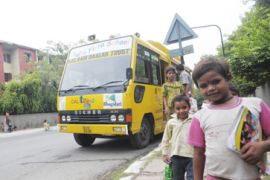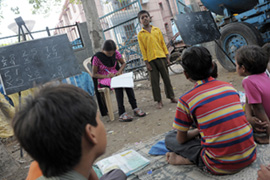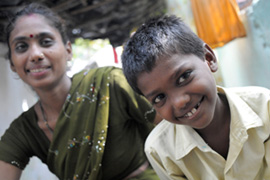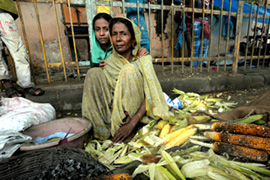India drives to educate
Teachers get on board the ‘school bus’ to take the classroom to India’s poorest pupils.

 |
| Teachers in India are determined to teach the least privileged children [DFID/Nick Cunard] |
Every morning, while carrying plastic bags of chopped green chillies and onions to his father’s tea stall in the Kali Bari area of New Delhi, eight-year-old Pramod would dread running into uniformed children walking to school.
His father needs the chillies and onions to make pakoras (deep-fried fritters), but Pramod would rather have been carrying a school bag.
Keep reading
list of 4 items‘We share with rats’: Neglect, empty promises for S African hostel-dwellers
Thirty years waiting for a house: South Africa’s ‘backyard’ dwellers
Photos: Malnutrition threatens future Afghan generations
“I felt ashamed at not being in a [school] uniform, carrying vegetables instead of books,” says Pramod who is just one of India’s five million school dropouts.
India passed the Right to Education bill in August, promising primary education to children aged between six and 14.
However, there are many obstacles to be crossed before the new act can be implemented.
Dropouts like Pramod are the children of migrant workers who come to the Indian capital for work and end up toiling as day labourers on construction sites.
The yellow bus
Many migrant families are daunted by the possible expenses of enrolling their children at a school in an unfamiliar city.
As villagers, they may not be able to provide birth certificates for their children – a basic requirement for school enrolment.
Another requirement – proof of residence – is impossible to provide when the only ‘home’ most of them know is a windowless, brick hovel covered with blue tarpaulin in a teeming slum.
 |
| The scheme has cut the number of dropouts from 25 to 5 million [DFID/Nick Cunard] |
For Pramod’s parents, even visiting a nearby school was difficult because they could not leave their tea stall where they work from early morning until late into the evening.
As the children start helping around the house and looking after younger siblings, all talk of attending school gradually fades.
But two yellow buses – equipped as mobile schools – are hoping to reach even the most deprived children and provide them with primary education.
The buses are part of the government’s successful Sarva Shiksha Abhiyaan project started in 2003 to get dropouts back into school.
“If the children can’t make it school, we have to take the school to them, to their doorstep,” says Sudhama, 25, a bus teacher who says that some of the 100 children who attend every day do not even know their age.
Funded by the UK Department for International Development (DFID) in India, the project has slashed the number of dropouts from 25 million to five million in five years.
‘Lost years’
| Education in India | |||||||
|
Equipped with a TV screen, books, puzzles and toys, the buses arrive near the four designated slums every morning.
Opposite a slum in the Kari Bari area of New Delhi, the children rush to greet their ‘school’. Since August is a hot and stifling month, the ‘classroom’ is moved outdoors.
The children hurriedly help the bus driver unload the easel and board, books, pens and dhurries – woven cotton rugs – which they spread out to sit on under the shade of a cotton silk tree.
“Some kids have lost a whole year. Others have never been to school. We get them up to the right level and then admit them into mainstream primary schools,” says Sudhama.
One powerful incentive for parents is that the books are free and their children receive a piece of fruit – not affordable otherwise – every day.
But it takes time to build up their trust.
Durgesh Gupta, a ‘community mobiliser’ who visits families to persuade them to send their children to the bus, says that child trafficking has made them fearful.
“They’re very suspicious of me at first. They know of children who have been snatched or lured away with sweets and never seen again,” he says.
Building trust
Gupta’s strategy is to ask for the children to come for just one hour initially. As the parents’ trust increases and they see their children learning, they eventually willingly send them for two hours.
The children sitting cross-legged on the dhurries are divided into two streams – the younger beginners and the older children who have occasionally attended school.
 |
| Shivam’s mother persuaded others to send their children to lessons [DFID/Nick Cunard] |
They start the day with a prayer. Then, books and slates out, they learn Hindi, multiplication, and some English words – elephant, dog, fish, cat and boy.
Spiky-haired Shivam, aged nine, came to Delhi from a village in Uttar Pradesh.
When his parents failed to enrol him, Shivam used to stay at home, carrying his father’s lunch to the construction site and helping his mother, Bittan, cook and wash clothes.
After joining the bus, he was thrilled with his new life and used to race home to tell his mother everything he had learnt. Lately, he has been leading the class in chanting the Hindi alphabet.
Bittan was so impressed that she persuaded other mothers to send their children, too.
“If I get an education, I can become a bus driver,” Shivam says with a grin. It is 10am and, after two hours of study, he puts away his slate and, with a jaunty air, sets off home peeling the orange he had been given.
‘Great pride’
“They feel a great pride in the bus because it comes specially for them. Without the bus, they stand no chance of getting back to school. It transforms their lives and gives them hope,” says Gupta.
Ten-year-old Shaheen is one of the 200 children who have now been ‘mainstreamed’.
|
“My mother told me … that sending me to school was out of the question because we were poor. When the bus came, I told her if she educated me, I would support her” Shaheen, |
She used to attend the mobile school which arrived near her home in the Muslim walled city, close to Turkman Gate, built by India’s Mughal emperors.
A few weeks ago, after a year with the bus, she was successfully enrolled at the local Guru Nanak school.
Shaheen says that, when she grow ups, she wants to be a doctor, not a street vendor like her mother, who sells roasted corn-on-the-cob to poor labourers.
Though young, she understands that education is the key to escaping the poverty she shares with her widowed mother, Mukiman, and her four brothers and four sisters.
“My mother told me years ago that sending me to school was out of the question because we were too poor. When the bus came, I told her that if she educated me, I would support her,” says Shaheen, proudly wearing her blue school uniform.
The project’s community mobiliser in the area had to visit Mukiman’s home several times before she agreed to send Shaheen to the bus.
“I have realised my daughter should study for as long as she wants to,” Mukiman says now.
Transformation
Shaheen says her life has been transformed since she used to stand outside her house watching other children go to school.
“I couldn’t count and I could write only a few words of Hindi,” she says. “Now I do multiplication and division and know some English too.”
Which English words?
“You are welcome” and “shut up”, she smiles, adding that the latter is necessary to silence her noisy siblings.
 |
| Shaheen’s mother, Mukiman, sells corn to support her nine children [DFID/Nick Cunard] |
Shaheen describes her transition from the mobile school to a Grade IV class as “smooth”.
“What I learnt on the bus prepared me. I adapted easily. On my first day I made friends with the whole class and I’m now the monitor,” she tells me.
A ‘proper’ schoolgirl now, Shaheen is confident and articulate. Her self-respect has been restored, her mother says.
She confides that before the school bus, she would have felt embarrassed if her school-going friends had come round to her house and started speaking English.
“I would have hung my head in shame. But now I know that soon, I’ll be able to speak English too.”
